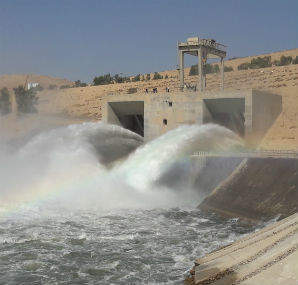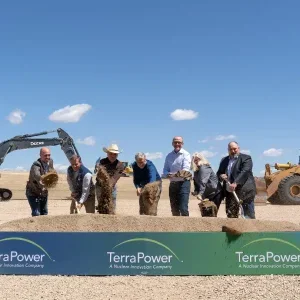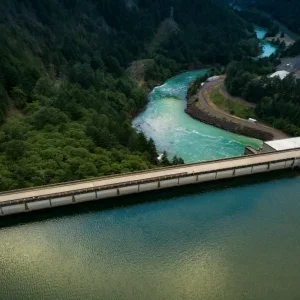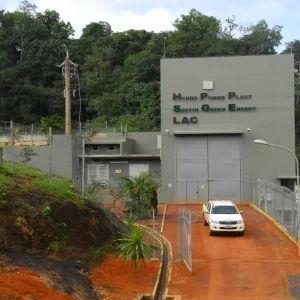
The Mosul embankment dam on the Tigris River in northern Iraq has had a troubled history since construction. The dam sits on soluble foundations, requiring continuous maintenance, and in recent years the local region has been troubled by war and security crises that make the safety work more difficult to perform.
Almost as soon as the dam was completed and the reservoir impounded, in the mid-1980s, it began to suffer worrying problems from foundation leakage. Major efforts at repairs to the foundation have been undertaken with numerous instances of contracts to execute massive grouting programmes to attempt to re-establish as far as possible the integrity of the cut-off wall. But, despite the many laborious and expensive efforts over subsequent years, the seepage problems have continued.
The challenge of dam safety became more heightened in recent years due to another dimension: the security climate. Terrorism and conflict has rolled back-and-forth through the north of the country, and elsewhere, and there continues to be fighting with Iraqi government forces. The conflict follows on from the previous disruption in dam repair efforts in the war that ended the government authority of Saddam Hussein.
In light of the ongoing safety problems, and while countering the problems posed by security challenges, the government – supported by the US, through the US Army Corps of Engineers (USACE) – launched another large-scale effort to reduce the critical foundation problems at Mosul dam. The government called upon the services of Italian company Trevi Spa, part of the foundation and ground engineering specialist contractor Trevi Group, for the massive volume of drilling and grouting work required to improve the performance of the dam’s deep cut-off wall.
Trevi was awarded the 18-month long remediation works contract for Mosul dam almost a year ago. After gearing up on site – and with security being ensured, including Italian military support to help ensure the safety of the project team and site – the main construction activities were underway with drilling set to commence by late 2016.
At Mosul, the latest round of remediation tasks involve repair to the bottom outlet structure of the dam, and also undertaking a huge programme of drilling and grout injection to enhance the integrity of the cut-off curtain. Some of the required drill holes are up to 200m deep for the grout injection.
Mosul Dam
Mosul dam is a 3.4km long earthfill embankment structure impounding a multi-purpose reservoir. The nearest major city to the dam and reservoir is Mosul.
The 113m high Mosul dam was constructed on the Tigris in the early 1980s, and completed in 1984. The embankment structure has a total volume of 37.7 Million m3, and two spillways: the main, gated spillway with a maximum capacity of 12,400m3/sec; and, a secondary, fuse plug spillway.
While the dam and reservoir have been of major strategic benefit in exploiting the local regional water resources, the geology of the site location is a huge problem. The geology is complex and soluble strata of a variety of rock types, such as limestone, gypsum, marls and anhydrite.
The complex geology is naturally prone to dissolution from groundwater flows and development of karstic voids, and this process has been exacerbated by the head of water in the impounded reservoir. Consequently, the dissolution weakens the foundation rock and therefore the effectiveness and integrity of the dam’s grout cut-off curtain. If the technical problems are not tended to accurately and with sufficient effort, and in a timely way, then the natural, ongoing process raises risks over structural integrity as well as the jeopardising the capabilities to perform its full water retention function.
Seepage problems begin
The Mosul dam embankment structure experienced major challenges from the outset due to the geological weakness below its massive body. The problems came despite the design and construction including a massive grout curtain along the axis, with injection holes having been drilled up to 200m deep, and the curtain being joined with the blanket grouting zone at the base of the embankment.
Problems became apparent when seepage was spotted following the initial impounding of the reservoir, in 1985. The seepage problems included the development of sinkholes. Despite having been completed, the dam has had supplementary grouting of its foundation from the outset.
Over subsequent years, the nature and scale of the geological and foundation weaknesses have became increasingly evident.
A near continuous grouting regime has been ongoing since the mid-1980s to limit the leakage problems at the strategic structure. Some of the works included foundation improvements executed by the Rokem joint venture, which was led by Rodio – a company later (in 2005) acquired by Trevi Group. Those works, confirms Trevi, involved an extremely large amount of drilling to support the grouting injection works aimed at improving the performance of the cut-off curtain.
The colossal amount of drilling done for the various grouting works over the years met with some success in engineering terms, helping to reduce the leakage somewhat. However, the authorities and all concerned fully recognised the problem would continue as its was due to leakage in the soluble soils. The dam, it was realised, would require much additional grouting into the future, and the tasks had to be performed steadily – as ongoing maintenance, in effect, albeit of an more extreme nature.
But the prolonged challenge of tending to the dam foundations has been troubled and exacerbated – and safety concerns heightened – by the conflicts in the country over the last 14 years.
Assessing a long-term problem
Following the defeat of Saddam Hussein’s regime in 2003, in the Second Gulf War, the US-led forces then began close inspection of all infrastructure, assets and capabilities in the country. The work was part of the transition to what would eventually lead to a new government for Iraq, though fighting has continued with many factions in conflict in the north and north west of the country, but sometimes it reached towards the capital.
One of the tasks undertaken, almost 10 years ago, was a review of the condition and needs of the still strategic Mosul dam. Studies included a review of efforts made since construction up until the time of the review, in 2007.
The findings were reported by US engineers supporting the Government of Iraq. The report was produced, in October 2007, by the US Office of the Special Inspector General for Iraq Reconstruction (SIGIR), and titled Relief and Reconstruction Funded Work at Mosul Dam (SIGIR PA-07-105).
The report outlined the various remediation works that had taken place, involving massive grout placement (1987-1998) as well as injecting grout on an ongoing basis. The first round of massive grout placement was just over 750 tonnes in 1987, then regularly was at least 100 tonne/year afterward – approaching 550 tonne in 1991 and 750 tonne, again, in 1998. The quantity of injected grout over 1986-2007 was typically around 200 tonne/year, on average.
In terms of the drilling performed, it was rare for the annual total distance to drop below a cumulative total of 14,000m. Most years, even from initial impoundment, the total drilling done was at least 20,000m and sometimes peaked up to 40,000m – 50,000m range.
The review concluded that despite the huge sustained effort and investment involved, the problems at the dam foundations were not sufficiently diminished. All the effort had not achieved significant and sufficient improvement.
In fact, water level fluctuations in the reservoir had led to alterations in groundwater flow and, over 2005-6, the development of yet more sinkholes which were also closer to the dam than others before.
Concerns raised for the long-term stability and safety of the dam led to studies by USACE and SIGIR, which noted seepage flows from the dam’s access gallery and to the sides of the main spillway.
Beyond what the report determines as a “flawed” choice made by consultants over choosing the location of the dam with respect to geology; and, it notes that an effort to save construction time had led to a choice – in the early 1980s, Iraq was at war with Iran – of completing the necessary grouting later, using a grouting gallery once the reservoir was impounded.
The studies also highlighted deficiencies of varying degree in the following plans, approaches and equipment to perform what the report acknowledges were complex improvement works that called for specialised grouting to be done in difficult conditions.
The challenge of sufficiently rehabilitating the dam has had many further difficulties, including last war and invasion of Iraq, and the ongoing conflict with control of the land in the area having been being lost and regained.
These problems led to a ‘significant reduction’ in the interventions planned in recent years, notes Trevi. But the specialist foundation contractor comments further that given the critical situation at the dam, the Government of Iraq – with the ongoing support of USACE – decided in late 2015 to push ahead with new impetus to tackle the foundation problem.
Latest grouting work
An international tender with an emergency procedure was issued for the maintenance and safety of Mosul dam. In addition to a Trevi division having previously worked at Mosul, the group has also worked on safety-critical cut-off wall improvements at other dams, such as Wolf Creek embankment dam in the US (see box panel).
Trevi SpA’s tender was successful for the latest Mosul remediation works and the company signed the contract in March 2016 by the Ministry of Water Resources. The total value of the contract is Euro273 Million, including the specialist foundation contracting services and provision of the necessary equipment for drilling and grouting (including mixing plants), and monitoring and control.
The 18-month contract includes approximately six months for mobilisation, set up of equipment and plant, and building accommodation for workers. The balance, and majority, of the contract period – about 12 months – is for the drilling and grouting tasks, explains William B Empson, Mosul dam task force lead engineer with USACE.
By late October the housing and grout plant were under construction, and drill rigs were already on site, he adds.
The contract includes works for the repair of the bottom outlet of the dam and massive grout injection work to strengthen the grout curtain, at depth. The initial focus is to tackle the weakness at identified critical areas, both at the surface and below the grouting gallery.
“There are many technical challenges associated with the work and each is addressed as it arises,” says Empson. “Continuous and consistent progress is being made on the work.’”
The work to improve the grout curtain will be executed from within the inspection tunnel with grouting operations performed via two long rows of holes drilled into the over the length of the gallery, says Trevi. The rigs are employing blow-out preventers due to the high heads involved (up to 8-10 bar) in the grouting work at depth.
“Engineers and geologists evaluate all of the information available for the dam, including the structure of the rocks below the dam and data from instruments,” says Empson.
“All of that data helps point to areas in the dam that require the most immediate attention. Drilling and grouting will begin in those areas,” he adds. “As grouting progresses and additional information is gathered, the locations, pressures and grout mixes will be adjusted on a daily basis.”
As the gallery tunnel environment is damp, and there is constant and heavy leakage of water, says Trevi, the contractor is using an electrical version of its sister company Soilmec’s SM-5 micro-drill rig to execute the drilling tasks for the grout injection. The core rig was exhibited at the most recent Bauma show. The electrical version of the rig is being used as exhaust emissions need kept to a minimum while still having a small, powerful, drilling system.
At the bottom outlet, the task is to repair a safety floodgate and involve works at the electromechanical parts and calls for the use of divers as well as specialist sub-contractors.
With most construction activities to take place in 2017, the contract is due to be finished before the end of the year, says Trevi.






